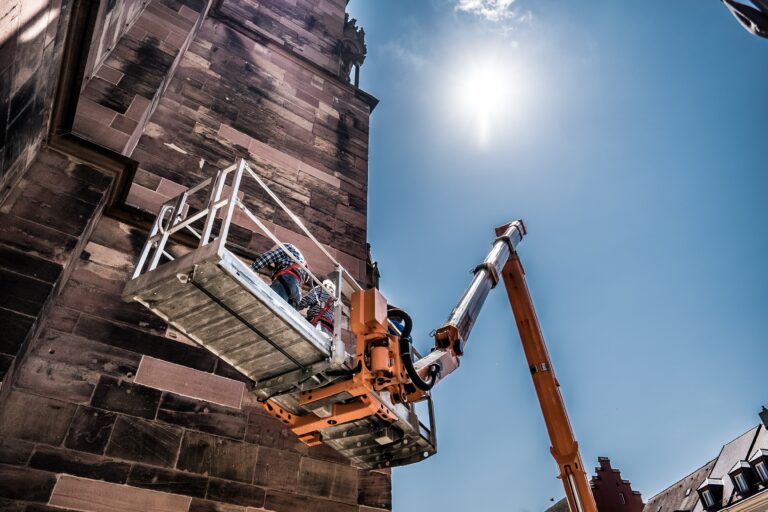
A few weeks ago, we covered some top applications of digital twins, including large scale robots, injection molding machines, and more. These applications relate to the dynamic, physics-based digital twins that we focus on here – not the sensor-based digital twins that are built only after the machine is in operation. This week, we’ll look at a specific case study on how physics-based digital twins were used for vibration control of a warehousing cable robot. The robot, seen below in a prototype, uses a fast-moving cable system that offers many advantages, but needed to be precisely controlled to maintain stability – a perfect use case for a dynamic, digital twin.
The Story
In the fields of industrial automation and robotics design, engineering challenges present themselves at all stages of development. Machines are often intended to run as fast as possible, since speed is one of the key factors in the efficiency of an industrial environment. The increasing speed of these machines, however, results in new and complex problems to solve. When running machines at high speeds, changes in both direction and speed can cause significant forces on machine components. Without the proper control strategies for high-speed machines, engineers risk damaging machine components, jeopardizing the safety of both the machine and any nearby operators.
As part of the High-Speed Robotics Lab at the University of Waterloo, Dr. Hamed Jamshidifar researches technologies that can aid in the development of new robotics technologies. He uses modeling and simulation as a key strategy to better understand the dynamics of high-speed robotics. In a recent project, he was studying the dynamics of a high-speed warehousing cable robot. These robots are intended for use in warehouses, where products need to be moved over large workspaces at high speeds. By taking advantage of cable systems to move the robot between locations, Dr. Jamshidifar’s design can provide faster operation than traditional warehousing robots.
Using Digital Twins
To achieve the high speeds possible with the new robot design, motion and vibration control would be a crucial part of the design process. Without high-fidelity machine controllers, the cable-driven robot would be easily susceptible to unwanted vibrations and other unintended motion that would impede performance and risk damaging the actuating motors and surrounding environment. Dr. Jamshidifar chose MapleSim, the modeling and simulation tool from Maplesoft, as a key technology to understand the robot’s dynamics and develop control systems for vibration control and minimization. While other modeling and simulation tools exist, MapleSim offers a dedicated Ropes and Pulleys Library which allowed him to easily incorporate cable dynamics in his simulations.

To create the robot model in MapleSim, Dr. Jamshidifar imported his pre-existing CAD model of the robot’s moving platform. By importing his CAD model, he could automatically import the platform’s geometries, mass and inertia information, and the 3-D model information for visualization purposes. The model was then completed by connecting standard MapleSim components, including pulleys, winches, and cables. For the purposes of testing the model, the winches were actuated by simplified forces to simulate the movement of the robot along a rectangular motion path.

To validate the model accuracy, simulation results were compared against a small-scale physical prototype that was previously constructed. This would ensure that the basic dynamics of the MapleSim model were aligned with the expected results during operation.

The Results
The simulation results for the robot could be visualized in MapleSim using a 3-D representation of the pulley systems in combination with the previously imported CAD. The initial simulation results show the problematic vibrations of the central platform. Without proper motion control, these vibrations would limit both the speed and safety of the robot’s operation. The MapleSim model would be used to test and validate various control strategies to minimize these vibrations, while still allowing for the maximum safe operation speeds.

The second set of simulation results show the results of an elementary control strategy to minimize vibrations. The motion was compared against the previous, non-controlled results, showing the amount of vibration that was eliminated during the motion profile. The simulation results pictured are still only the product of preliminary attempts to reduce vibrations – Dr. Jamshidifar intends to develop control strategies and algorithms that will further reduce the vibrations in all operating conditions.
Dr. Jamshidifar was able to demonstrate that the unwanted vibrations in his cable-driven warehousing robot could be minimized with the correct vibration control strategies. By continuing to use MapleSim for his research and development, he will be able to minimize the chance of issues when developing physical prototypes, having already eliminated various issues in the MapleSim model. As he continues to develop the robot model, Dr. Jamshidifar plans to use his MapleSim models to accurately develop control strategies and algorithms that can bring faster, better robots to market for warehousing applications. The team has currently developed a full-scale prototype, with plans to bring the robot to commercial markets in the future.
This story originally appeared as a case study on maplesoft.com.







